New perk! Get after it with local recommendations just for you. Discover nearby events, routes out your door, and hidden gems when you sign up for the Local Running Drop.
How an original epicenter for ultrarunning elites became one of the world’s best towns for the average runner
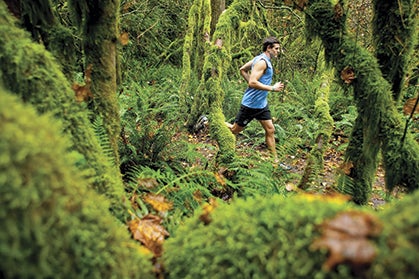
Brian Bauer enjoys the lushness at Tiger Mountain, Central Cascades, Washington. Photo by Stephen Matera.
The archetypal Seattle success story features an unassuming genius mastering a revolutionary craft in obscurity before exploding to international prominence and changing the world. It happened with a number of different Seattleites—when Jimi Hendrix released “Are You Experienced?”, with Bill Gates and Microsoft and the personal computer and again when Nirvana released “Nevermind,”back when grunge was something other than fodder for BuzzFeed list topics.
In the world of ultrarunning, it also happened with Scott Jurek, who reached the peak of his ultrarunning career—winning everything from the 135-mile Badwater Ultramarathon to Greece’s Spartathlon 245K to the Western States 100, seven times in a row—while living and training in Seattle from 1999 to 2010. Of course, talent never occurs in a vacuum and, just as Nirvana’s success depended on a complex scene of talented musicians and promoters in Seattle, Jurek’s success had a lot to do with the community he lived in. In fact, his individual brilliance peaked in a scene that was, according to ultrarunning legend Dr. David Horton, “the epicenter of the trail-running world” at the time.
Over the years, many trail-running cult celebrities have lived in the Seattle area and trained in the foothills of the Cascade Mountains just east of the city—Hal Koerner, who’s won multiple 100-mile races from Hardrock to Western States to Javelina, former Ultra-Trail du Mont-Blanc record holder Krissy Moehl, Hardrock 100 record holder Kyle Skaggs, and four-time USA Track and Field (USATF) Mountain Runner of the Year Joe Gray. The list of races that Seattleites have won over the years covers the gamut of notable ultras, both locally and internationally—Western States, Hardrock, Badwater, Ultra-Trail du Mont-Blanc (UTMB), White River, JFK and Chuckanut, to name just a few—but most of those victories took place prior to 2009.
In light of these successes, it is almost as remarkable that today, Seattleites rarely win races of national or international importance. Few would consider Seattle today to be even a top-five center for elite ultrarunners, nor even the ultra-racing capital of the Pacific Northwest; runners from the region have notched victories at the Western States 100, for example, each of the last three years, but these runners were based in Oregon (Pam Smith and Tim Olson) and British Columbia (Ellie Greenwood).
Of Seattle’s elite ultrarunning community in the 1990s and early 2000s, local masters elite Adam Hewey says “The ‘scene’ based out of there was a pivotal time in the sport and, like grunge, it changed and moved on.”
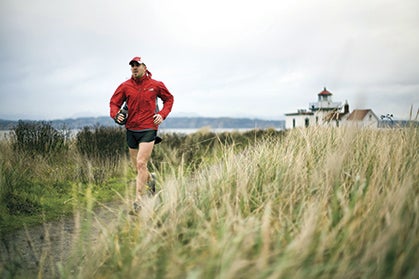
Sam Thompson enjoys miles of singletrack along Puget Sound in Seattle’s 534-acre Discovery Park. Photo by Michael Hanson/Aurora Photos.
Fertile Ground
In the late 1990s, Seattle was exactly the kind of place that could support the development of a fringe sport like ultrarunning. At a time when it was impossible for a trail runner to make a living from prize purses, Seattle was a major economic center with a booming outdoor recreation industry and culture. Runners could find employment at locally headquartered companies like Montrail, REI and Brooks.
Seattle also boasts one of the most extensive trail networks in the country, with hundreds of miles of cushy, pine-needle-covered trail accessible within a half-hour drive of the city. Within a few more hours’ drive, an even wider variety of terrain is accessible, ranging from alpine ascents to high desert to coastal rainforest. The temperate weather—not actually that bad, no matter what you’ve heard—allows easy, year-round access to those trails.
“I have always run in the mountains since I was a young kid,” says Joe Gray, who grew up in the suburbs of Seattle. Though some runners prefer training at altitude for the aerobic benefits produced by thin mountain air, Gray sees an advantage to Seattle’s sea-level trails. “You can train hard and recover fast because of the low altitude…[When] I have been in Colorado, the hardest thing to deal with is the recovery. You can have a great workout one day and a week later the worst workout ever.”
Saint McCoubrey and the Glory Years
Many locals point to Scott McCoubrey as the visionary who tapped into the city’s potential to become the nation’s trail-running capital. With his uniform of long, dirty-blond hair, old jeans and a T-shirt, McCoubrey gives off the air of a lifestyle runner—the type who, at any moment, might pick up to live in a van in the mountains. A former ski bum who grew up in the area, he started running to stay fit after an injury forced him off of the slopes.
After immersing himself in early trail and ultra culture, in 1999, McCoubrey and his wife, Leslie, opened the now-legendary Seattle Running Company (SRC). The store, a former FootZone franchise, quickly became a gathering place for trail runners—a sort of granola Cheers, where people would bring food, organize parties and hang out alongside making gear purchases. In his book Eat and Run, Jurek likened the scene to “the corner bar where all of the punk rockers or skateboarders or cops hang out, except the people hanging out at the shop wore running shoes and swapped stories about electrolyte consumption.”
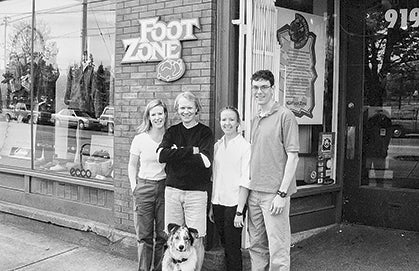
In Seattle’s Capitol Hill neighborhood, Leslie and Scott McCoubrey, Leah Kangas and Scott Jurek stand outside the FootZone store, which they would transform into the Seattle Running Company. Photo by Martin Rudow.
The store flourished for several years and, with the presence of so many who shared a passion, a strong trail-running community developed. Local runner and well-known race photographer Glenn Tachiyama described it as a time of “get togethers, potlucks and game nights” as much as a time of intense training regimens or race strategizing.
The usually talkative McCoubrey was demure when asked about his role in developing such a trailblazing business. He has said that he and Leslie were intentional about creating “a home for wayward ultrarunners”—but he downplays his own importance and insists, “it was the community that drew people together.”
The Seattle community, however, would not have been what it was without McCoubrey’s efforts to establish a fervent trail culture in the area. He accomplished this partly by recruiting elite trail runners to work at the SRC. Jurek himself originally moved to Seattle after being offered a job at the store, and the employee alumni list reads like a race leader board from that time—Jurek, Moehl, Koerner, Ian Torrence, who in 2002 won the HURT 100 and finished on the podium at the JFK 50, Brian Morrison, who nearly won Western States at a legendary race in 2006 where he collapsed with hyponatremia 100 yards from the finish, and 2007 top-5 Western States finisher Phil Kochik, among many others. Dr. David Horton of Lynchburg, Virginia, visited the area frequently during that period and said that “going to his store and meeting all of the workers … was like a runner making a trip to Mecca.”
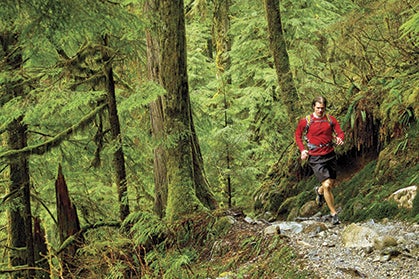
Joe Bauer runs the Lake 22 trail, Mountain Loop Highway, Central Cascades, Washington. Photo by Stephen Matera.
While running the store, McCoubrey also worked for the shoe manufacturer, Montrail, when it was still a fledgling Seattle business. He was integral to shaping their focus as a trail-running brand; he helped develop the concept of trail-specific running shoes and, with his direction, Montrail pioneered the first sponsored team of trail runners. They supported up to 90 runners at a time, many of them locals signed personally by McCoubrey.
Shrewdly, McCoubrey also used his Montrail connection to draw runners to the area by establishing the national importance of a local, then relatively small, race—the White River 50—soon after taking over as race director in 2001. The race was a passion project for McCoubrey because he’d spent his childhood skiing in the area. Montrail, at the time, was offering $5,000 to the winner of the USATF Trail 50-Mile championship, so when McCoubrey took over as director for White River, he worked with USATF to establish it as the championship, hoping that the prize purse and “Champion” title would attract the most competitive runners.
Participation at the race doubled between 2000 and 2001, and competitors during its championship period from 2001 to 2010 included local elites like Adam Lint and long-time record holder Uli Steidl, as well as outside, international-level talent: Ann Trason, Dakota Jones, Anton Krupicka, Ellie Greenwood, Nikki Kimball and Timothy Olson.
In another testament to McCoubrey’s humility, he offers sparse commentary on his own influence for this story, but says that establishing significant prize money for that race was pioneering at the time. Almost as a side note, he admits that his work in the Seattle area “really promoted the sport on a national level.”
Part of that national impact involved attracting top runners to the still-fringe sport; two of the era’s best trail runners—Uli Steidl and Kyle Skaggs—may not have entered the scene if not for the atmosphere that McCoubrey helped establish in the Seattle area.
German transplant Uli Steidl was perhaps the best 50 miler in the country for a time—holding the record at White River between 2003 and 2009, when it was the national championship race. An “unstoppable German Machine,” in local runner Maxwell Ferguson’s description, seemingly made entirely of quad and hamstring, Steidl is a 10-time Seattle Marathon winner who had raced on the mountain-running circuit in Europe as a teenager, but had focused on road racing during his time in the States. However, he says, “After I read the story about Scott [Jurek] winning Western States for the first time … I thought it would be fun to go on a training run and show this ultra guy that road/track runners can run fast in the mountains.”
Steidl approached Jurek at the Seattle Running Company, and still remembers their first run together developing into a one-on-one race on a steep, rugged trail on Granite Mountain in the Central Cascades. The run essentially ended in a dead heat—Steidl beat Jurek by a minute on the ascent, and Jurek beat him by a minute on the way down.
“After that first run, we ended up going on many more long runs in the mountains,” Steidl says. “Running with [Scott] helped me get into ultras.”
When a young, local runner named Kyle Skaggs was first introduced to trail running, he was a scraggly, unknown cross-country athlete at Evergreen State College in Olympia, Washington, whose biggest running achievement in college was a 74th-place finish at a regional championship. His coach was aware of the local ultra scene, and through his recommendation Skaggs was introduced to trail running. He immediately excelled. Brian Morrison first met Skaggs in 2005 at the Tiger Mountain Fatass 25k just outside of Seattle.
“He was wearing giant wool socks and the oldest Asics I’d ever seen,” Morrison says, “but when we started running I could barely keep up with him.” On their race, which ended in a tie: “We finished together, but it seemed a whole lot easier for him than it was for me.”
In 2006, after Skaggs finished at Evergreen State, McCoubrey signed him to a Montrail sponsorship and he put together a streak of remarkable performances. He set the still-standing Fastest Known Time on the 96-mile Wonderland Trail around Mount Rainier and, in 2008, shattered the record at Colorado’s Hardrock 100-Mile Endurance Run—putting up a time that Andy Jones-Wilkins called “the greatest single race in trail ultramarathon history.” No one has come close to rivaling his record in the years since.
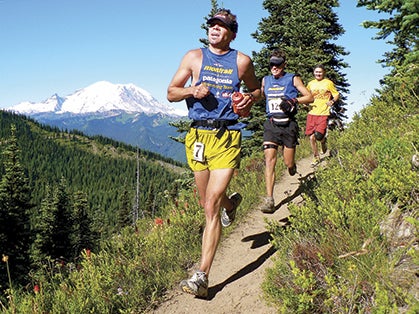
Hal Koerner on his way to winning the 2005 White River 50, with Ian Torrence and race director Scott McCoubrey on his heels. Mount Rainier looms in the background. Photo by Glenn Tachiyama.
The End of Seattle’s Elite Era
As Evergreen Trail Runs race director Roger Michel says, the period during which Seattle was the center of the world for fast ultrarunners seemed like a bubble for many locals: “It was like one day all of the elites were here, and then all of the sudden they weren’t.” There doesn’t seem to be one clear reason that things changed, but it is true that many elite runners dispersed during a tumultuous period from 2008 through 2011, when the community in Seattle took a variety of only partially related hits.
Perhaps most importantly, in 2010, the Seattle Running Company closed. Morrison, who was an employee at the time, notes that the store had suffered substantial financial losses; shortly after an expensive remodel, a building closure forced it to move from its longtime location. Though it remained open for a few years in the new spot, unexpected debt from the move meant that it wasn’t viable in the long run. The store was replaced by a Fleet Feet franchise, ownership changed and the focus shifted away from the trails.
At about the same time, financial support for the local ultrarunning scene took another major hit—in 2006, Columbia bought Montrail and moved its headquarters from Seattle to Portland. Two years later, Montrail greatly pared down the number of ultrarunners it provided sponsorship, reducing their ultra team from 90 to 12. Signaling the end of the SRC/Montrail era, in 2010, Scott McCoubrey moved to Idaho to work as the Footwear Manager for Scott Sports, a position he still holds.
At the same time, elite runners had been slowly moving away or shifting their focus. Former SRC employee Hal Koerner had moved to Ashland, Oregon, to start his store, Rogue Valley Runners. Kyle Skaggs moved to Colorado before retiring from running to a farm in New Mexico. Scott Jurek and Krissy Moehl both moved to Boulder to train at altitude and chart new directions. Uli Steidl refocused on his road-racing career. Brian Morrison began developing a business and raising a family. And so, as quickly as they had gathered, many of the most influential and competitive members of the trail-running community dispersed.
“Once the momentum starts to build elsewhere, all the top runners want to be where all the other top runners are,” says James Varner—race director at Rainshadow Running, and the runner who introduced Kyle Skaggs to McCoubrey.
“What was lost was the sense of family,” says Tachiyama. “[Jurek, Moehl, Koerner and the others] are foremost friends, not idols.”
While Washington State still produces fast runners, today it has become difficult for top locals to find training partners and community with other elite-level trail runners. “I wish I had one or two people I could consistently do hard runs with,” says Maxwell Ferguson, a local with a string of impressive ultra performances in 2013. “I can definitely sense the huge benefit of having consistent year-round speed-work partners.”
In the mid 2000s, someone like Joe Gray, until recently a lifetime Seattle-area runner, could have found multiple elite training partners. Now, says Ferguson, “To be honest, [Gray] is so much faster than everyone around that we aren’t really of much help to him.”
“Seattle is such a social city,” Gray counters, “that you can easily find someone who loves to be outdoors, or who loves to just run, who will travel to the trails every week with you.” Nevertheless, at the end of 2013, Gray joined the elite exodus to Boulder. He admits, “Having the support of a coach and a few other elites to train with has made a difference.”
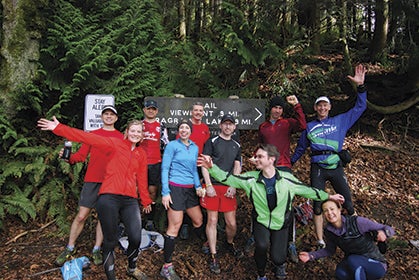
The Seattle Running Company Club ventures north of the city to the Chuckanut Mountains for a group run at Fragrance Lake. Photo by Win van Pelt.
The Great Washington Hope
On a cold Sunday morning last October, a dozen runners gathered at a trailhead within an hour’s drive of downtown Seattle for a 4.5-hour scenic loop through the Central Cascades, including ascents to the blue, alpine Pratt and Melakwa lakes. The group, which consisted of men and women of mixed ages and abilities, was part of the Seattle Running Club—founded in 2003 by McCoubrey and current president Win Van Pelt with a vision to introduce new runners to the trails and build community.
Some of the members present had run mountain 100-milers, some were training for upcoming first 50Ks and one young runner named Emilee McLernon had never run trails before. “[The run] brutalized me!” she jokes. “I showed up without food or water and they made fun of how small my tread was. Oh, I’ll be back though!”
While Seattleites may mourn the passing of the community’s remarkable competitive era, there is a parallel, more hopeful, narrative about local trail running. During all this, Seattle has developed into a remarkably good area for the average trail runner.
James Varner, who’s played a central role in recent years in expanding trail events in Washington, says, “I was definitely influenced by what was going on in the Seattle scene—the group runs, the way everyone seemed to volunteer and or race at every local race year after year. I like to think I’m continuing the tradition of inclusion that this area has always been known for.”
Local trail-running groups and clubs have proliferated in recent years—ranging from the 800+ member Seattle Mountain-Running Group to the women’s High Heel Running Group. Race options have grown exponentially, with races of all distances, fatass-style events and group runs taking place every weekend year-round.
In some ways, even the closure of the Seattle Running Company may have done its part to boost the sheer volume of trail-running opportunities in the area; former SRC employees, accomplished trail runners themselves, now operate three of the most prominent running stores in the area and have continued key aspects of the SRC ethos, including a passion for community on the trails.
“The biggest thing I learned from Scott and Leslie [McCoubrey] was the importance of surrounding yourself with good employees,” says Brian Morrison, who took over ownership of the local Fleet Feet and regularly holds trail-focused events, film screenings and group runs with guest-star trail runners. “About half of the staff consider themselves trail ultrarunners, and I’m always extolling the benefits of trails to our [road] marathon and half-marathon training participants.”
Eric Sach, another former Running Company manager, now operates The Balanced Athlete in Renton, a suburb south of the city, and started his own series of group trail runs at the start of 2014 jointly with the Seattle Running Club. “My take away from the Seattle Running Company days is that relationships matter. Even seven years after I left SRC to open The Balanced Athlete, my relationship with Scott McCoubrey and others is still strong. I know I can count on them when needed.”
And, former top-five Western States finisher Phil Kochik opened the trail-specific Seven Hills Running in one of the city’s western corners last year as an attempt to recreate a new center for the trail-running community in Seattle. He believes that it is the first store in the country to carry more trail-running products than road. His store regularly hosts lectures from trail runners and supports local races, and he employs visible members of the local ultra community, including noted race photographer Glenn Tachiyama. And, in 2014, Seven Hills announced that they would be supporting a new, local ultra-team featuring a variety of fast or influential local runners.
“This all ties back to Seattle Running Company,” says Kochik, “because that’s what they brought to the table—a trail-running clubhouse where you can hang out and get inspired.”

Seattle Running Club members exuberant in the high country. Photo by Win van Pelt.
A Center for Remarkable Everyday Runners
Some of the same factors that initially brought the elites together—community, a world-class trail system, competition, word of mouth—have drawn an expanding number of people into the sport. While the community no longer centers around a core group of fast runners the way that it once did, the Washington ultra scene has an egalitarian atmosphere that, appropriately enough, reflects another aspect of McCoubrey’s original vision—that “anyone could come out, and anyone can run an ultra,” as local Adam Gaston described it.
The fact that Seattle’s best-known runners are famous for things other than running is an interesting reflection of that egalitarianism, and of the accessibility and growth of the local ultra scene. Ben Gibbard, the lead singer for the bands Death Cab for Cutie and the Postal Service, is a Seattle Running Club member who has completed multiple ultras. And Matthew Inman, the creator of the web comic “The Oatmeal,” introduced millions of readers to the White River 50 when he wrote several web series about his experiences training and running it. From his blog: “After you’ve been running for 8+ hours every little thing becomes an incredible luxury; at mile 21 I drank a cup of flat Mountain Dew and I swear it tasted like unicorn tears.”
And it is telling that, today, a certified “back-of-the-packer” is arguably the closest thing Washington State has to a running celebrity. Ras Vaughan, also known as Ultrapedestrian Ras, is a dreadlocked Rastafarian runner, blogger and podcaster who’s been working to expand the definition of what it means to be a successful, influential runner. He routinely sets out to establish “OKTs,” or Only Known Times, on routes and distances that haven’t yet been attempted, but which capture the imagination. His signature runs so far have been a double loop of the 96-mile Wonderland Trail around Mount Rainier, and a six-time unsupported crossing of the Grand Canyon. Despite these remarkable accomplishments, he will likely never win a race, and his focus is on promoting running for the vast majority of people, who aren’t routinely at the front of the pack.
“My goal in covering crazy distances by foot isn’t to prove that I’m different,” he says, “but to experience the fullness of being an average human. Ordinary people are capable of amazing and extraordinary things.”
And perhaps no event encapsulates the Washington running community—its storied past and its accessible present—like the Baker Lake 50K/100K Ultra Trail Runs. Originating in 2002, the race is one of Washington’s oldest ultras, and its annual October running marks the end of the Washington summer race season. The course traverses soft, rolling trail along the eastern edge of an alpine lake in the North Cascades, and features constant expansive views of Mount Baker to the north, assuming the low autumn clouds haven’t set in.
No women, and few men, have run the 50K faster than Krissy Moehl’s 4:40 in 2004, and the locals who organize are as old school as they come. In 2013, the race was directed by Terry Sentinella, a Badwater top-10 finisher in 2012. Former White River and Cascade Crest 100 winner Shawna Tompkins stood by and grilled burgers for finishers throughout the day.
The post-race crowd included local heroes like Brian Morrison and Adam Hewey, Ben Gibbard and a gang of well-dressed hipster friends, a number of first-time ultrarunners, and a host of familiar-faced locals who seem to show up for any race that’s likely to provide them with more than five hours of fun on the trails. It was a sunny day, and for hours after the race, this crew of runners mingled–Gibbard and Morrison making jokes about GI issues, and sore racers icing legs while downing beers and burgers.
At the finish line, a crowd waited until nearly midnight, wrapped in sleeping bags to fight off the chilly mountain air, to welcome back the final finishers of the 100K. Things looked and felt the way so many Seattle-area ultras used to—speedsters celebrating their peers’ finishes as much as their own victories, and a radically diverse crowd hanging out, united by the trails.
This article originally appeared in our April 2014/DIRT issue.